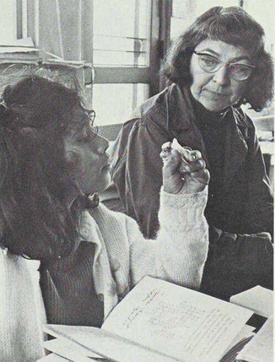Woesha Cloud North facts for kids
Quick facts for kids
Woesha Cloud North
|
|
|---|---|

North teaching in the experimental school at Alcatraz, 1971
|
|
| Born |
Anne Woesha Cloud
September 7, 1918 |
| Died | October 10, 1992 (aged 74) |
| Nationality | American |
| Other names | Woesha North |
| Occupation | teacher, artist, activist |
| Years active | 1941–1989 |
| Children | 5; including Renya K. Ramirez |
| Parent(s) | Elizabeth Bender Roe Cloud Henry Roe Cloud |
| Relatives | Chief Bender (uncle) |
Woesha Cloud North (September 7, 1918 – October 10, 1992) was an important American artist, teacher, and activist. She was a member of the Ho-Chunk and Ojibwe Native American tribes.
Woesha taught in public schools and later at universities. She also played a big part in the Occupation of Alcatraz. This was a time when Native American activists took over Alcatraz Island to bring attention to Native rights. Woesha helped run a special school there. She was also active in groups that supported women and Indigenous people. After she passed away, she was honored for her work. She was added to Stanford University's Multicultural Alumni Hall of Fame in 1995.
Contents
Early Life and Education
Woesha Cloud North was born Anne Woesha Cloud on September 7, 1918. Her birthplace was Wichita, Kansas. Her parents were Elizabeth Georgiana (née Bender) and Henry Roe Cloud.
Her father, Henry Roe Cloud, was a teacher. He started the American Indian Institute in Wichita. He also led the Haskell Institute. Her mother, Elizabeth, was also a teacher. She helped manage the Institute.
Woesha was the second of five children. Her parents strongly believed in higher education. Woesha went to Vassar College and earned her degree in 1940.
Career and Activism
After college, Woesha worked for the Bureau of Indian Affairs. She taught arts and crafts on the Pine Ridge Indian Reservation. In 1943, she married Robert Carver North. While he was serving in World War II, Woesha earned a master's degree in painting from Ohio University in 1944.
The couple later moved to California. Woesha focused on raising their five children. Her daughter, Renya K. Ramirez, became a well-known anthropologist.
Teaching and the Alcatraz Occupation
Woesha was also an artist and showed her work in the San Francisco Bay Area. In 1961, she started teaching art in the Palo Alto public schools.
In December 1969, Woesha joined the Occupation of Alcatraz. This was a protest by Native American people. They wanted to bring attention to their rights and treaties. A school was started on Alcatraz Island called the All Tribes Elementary School. Woesha began teaching there. Students learned regular subjects like reading and math. They also learned about Native American culture. Woesha stayed on the island during the week. She went home on weekends to be with her family. She continued teaching art on the island until the occupation ended in June 1971.
Supporting Native American Women
In 1970, Woesha helped start the National Indian Women's Action Corps. This group aimed to empower Native American women. She was the secretary of this organization. She also helped create the American Indian and Alaska Native Caucus. This group was part of the American Public Health Association. In the early 1970s, she began teaching at San Francisco State College. She earned another master's degree in art education from Stanford in 1972.
Later Life and Art
In 1975, Woesha moved to Lincoln, Nebraska. She earned her PhD in educational history and philosophy in 1978. This degree was from the University of Nebraska–Lincoln. She then taught in the ethnic studies department there.
Woesha continued to create and show her artwork. Her paintings were shown in various exhibits. These included shows in the Bay Area and at the Heard Museum. Her art was also featured at the Governor's Minority Art Native American Exhibit in Sacramento in 1975. In 1983, her paintings were part of an exhibit at the Sioux Indian Museum in Rapid City, South Dakota.
Her early paintings were realistic. Later, she used symbols, cubism, and impressionism in her art. She often showed family as part of the universe. She blended in traditional Native elements. In 1984, she moved to Fresno to be closer to her daughters. She taught at California State University until she retired.
Death and Legacy
Woesha Cloud North passed away on October 10, 1992, in Fresno.
After her death, her artwork was shown in an exhibit in 1995. This exhibit was called Our Art, Our Voices: Native American Cultural Perspectives. It honored the 25th anniversary of the Stanford American Indian Organization. In 1996, she was added to Stanford's Multicultural Alumni Hall of Fame. This honor recognized her great service to the American Indian community and to society.
See also
 In Spanish: Woesha Cloud North para niños
In Spanish: Woesha Cloud North para niños

